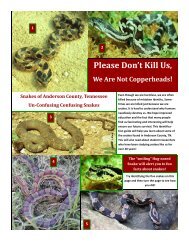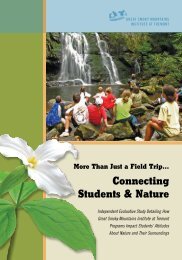Lichen Lesson - Great Smoky Mountains Institute at Tremont
Lichen Lesson - Great Smoky Mountains Institute at Tremont
Lichen Lesson - Great Smoky Mountains Institute at Tremont
Create successful ePaper yourself
Turn your PDF publications into a flip-book with our unique Google optimized e-Paper software.
EFFECTS OF<br />
AIR POLLUTION<br />
Schoolyard <strong>Lichen</strong> Survey<br />
LICHEN<br />
MONITORING<br />
Subject Area: Science<br />
Activity time: 60 minutes<br />
Setting: Schoolyard and<br />
classroom with computer<br />
connection<br />
Skills: Analyzing, Applying,<br />
C<strong>at</strong>egorizing, Collecting inform<strong>at</strong>ion,<br />
Comparing, Contrasting,<br />
Discussing, Hypothesizing,<br />
Inferring, Measuring,<br />
Summarizing<br />
Vocabulary:<br />
• Biological Inventory: A<br />
technique used by scientists to<br />
make a count of a particular<br />
species or ecosystem <strong>at</strong> one<br />
point in time.<br />
• Biological Monitoring: A<br />
technique used by scientists<br />
to check the condition of a<br />
particular species or ecosystem<br />
over time. Monitoring<br />
usually consists of comparing<br />
inventories with one another<br />
to establish trends.<br />
• Crustose: crust-like lichen<br />
growth form with the<br />
lower surface growing on<br />
and among the particles of<br />
it’s substr<strong>at</strong>e (rocks, bark...).<br />
Crustose lichen cannot be<br />
removed from the substr<strong>at</strong>e in<br />
one piece.<br />
• Foliose: leaf-like lichengrowth<br />
form with a fl<strong>at</strong>tened<br />
body and distinguished upper<br />
and lower surfaces.<br />
• Fruticose – shrubby or hairlike<br />
lichen growth form with<br />
no distinguishable upper and<br />
lower surface. Fruticose lichen<br />
either stands erect or hangs<br />
down from it’s substr<strong>at</strong>e.<br />
• <strong>Lichen</strong>: A lichen is a miniecosystem<br />
consisting of <strong>at</strong><br />
least two organisms: a fungus<br />
and a photosynthetic partner<br />
(algae or cyanobacteria).<br />
• Symbiosis – the living together<br />
of unlike organisms; it<br />
may be for mutual benefit or<br />
not.<br />
M<strong>at</strong>erials:<br />
For each group:<br />
• Pencil<br />
• Wet erase marker<br />
• Compass<br />
• String<br />
• Scissors to cut the string<br />
• Tree identific<strong>at</strong>ion book<br />
(optional: see extension activity #1)<br />
• <strong>Lichen</strong> Growth Forms sheet<br />
(page 3)<br />
• <strong>Lichen</strong> Grid transparency (page<br />
4)<br />
• <strong>Lichen</strong> Biomonitoring D<strong>at</strong>asheet<br />
(page 5)<br />
• Measuring tape<br />
• Four clothespins<br />
• D<strong>at</strong>a sheet<br />
• Clipboard<br />
• Magnifying lens<br />
Objectives:<br />
1) practice identifying lichen<br />
growth forms by their physical<br />
characteristics<br />
2) g<strong>at</strong>her baseline d<strong>at</strong>a by determining<br />
the percent of lichen coverage<br />
on tree species found in the<br />
schoolyard<br />
3) determine if there is any change<br />
in lichen coverage over time (longterm)<br />
4) <strong>at</strong>tempt to correl<strong>at</strong>e any changes<br />
in lichen coverage to environmental<br />
factors such as air quality/<strong>at</strong>mospheric<br />
pollution (sulfur dioxide,<br />
ground level ozone, acid rain)<br />
Background:<br />
This activity replic<strong>at</strong>es the activity<br />
th<strong>at</strong> is completed by students in the<br />
Smokies but can be done in your<br />
own schoolyard. For this activity<br />
it will be important to focus on the<br />
differences between one lichen<br />
growth form and another. Use the<br />
“<strong>Lichen</strong> Growth Forms” worksheet<br />
(page 3) to help in identifying.<br />
Copy the <strong>Lichen</strong> Grid (page<br />
4) onto transparencies. Copy front<br />
and back the <strong>Lichen</strong> D<strong>at</strong>a sheet<br />
(page 5).<br />
Select trees for your students to<br />
study, we prefer to have students in<br />
groups of 4 or less. For comparison,<br />
you can select trees species<br />
th<strong>at</strong> are all different or are all of the<br />
same. In general, it is better to select<br />
trees with less acidic bark (ash,<br />
elm, sycamore) but if th<strong>at</strong> isn’t possible<br />
then oak, beech, birch will do.<br />
Try to avoid trees with highly acidic<br />
bark such as Hemlocks as they are<br />
less likely to be able to n<strong>at</strong>urally<br />
support lichen popul<strong>at</strong>ions.<br />
Measure 4 ½ feet up from the<br />
ground (DBH height = diameter<br />
<strong>at</strong> breast height). Measure 5 ½<br />
inches up from this point and tie a<br />
string around the tree. Measure 5<br />
½ inches down from this point and<br />
tie a string around each tree. The<br />
students will be <strong>at</strong>taching their grid<br />
transparencies to this string using<br />
clothes pins. Label the tree with<br />
species name and tree number (you<br />
can have the students do this as an<br />
Parks as Classrooms <strong>Gre<strong>at</strong></strong> <strong>Smoky</strong> <strong>Mountains</strong> N<strong>at</strong>ional Park<br />
<strong>Lichen</strong>s 1
EFFECTS OF<br />
AIR POLLUTION<br />
LICHEN<br />
MONITORING<br />
extension activity).<br />
Procedure:<br />
(Steps 1-3 can be done in a separ<strong>at</strong>e<br />
class period if necessary)<br />
1. Students will need to know<br />
how to find the cardinal directions<br />
(North, South, East, West) using<br />
a compass. This step is important<br />
if you are setting up a long-term<br />
monitoring study. If you need instructions,<br />
please go to the website<br />
: http://www.learn-orienteering.<br />
org/old/lesson1.html<br />
2. Show students how to classify<br />
lichens into their three morphological<br />
groups, ID moss and bare bark.<br />
3. Show students how to read the<br />
d<strong>at</strong>a sheet, also have them fill out<br />
important inform<strong>at</strong>ion before going<br />
to their study tree (such as today’s<br />
d<strong>at</strong>e, group name, loc<strong>at</strong>ion).<br />
4. Explain to students which side<br />
of the tree you would like them to<br />
begin collecting (north, south, east,<br />
west). Remind them to use their<br />
compass to find th<strong>at</strong> side.<br />
5. Have students <strong>at</strong>tach their transparency<br />
grid to the appropri<strong>at</strong>e side<br />
of the tree using the clothes pins.<br />
6. Have students measure and record<br />
the tree’s circumference <strong>at</strong> the<br />
middle of their <strong>at</strong>tached transparency<br />
(4 ½ feet up from the ground).<br />
7. Have students estim<strong>at</strong>e and record<br />
the canopy cover when standing<br />
underne<strong>at</strong>h their study tree.<br />
8. Have students classify the lichen<br />
type found under each of the<br />
circle in square 1. Record this on<br />
the d<strong>at</strong>asheet in the square labeled<br />
“1”. They should have 10 marks in<br />
each square since all circles can be<br />
classified into one of the c<strong>at</strong>egories<br />
(crustose, fruticose, foliose, bare<br />
bark, moss).<br />
9. Repe<strong>at</strong> the previous step for all 9<br />
boxes.<br />
10. Follow the instructions on the<br />
d<strong>at</strong>asheet to calcul<strong>at</strong>e the total<br />
lichen coverage for th<strong>at</strong> side of the<br />
tree. [Count total number of marks<br />
for each lichen type, bare bark, and<br />
moss. Divide the number for each<br />
lichen type, bare bark, and moss by<br />
90 to get a decimal. Multiply these<br />
decimals by 100 to get the percentage<br />
of lichen coverage.]<br />
11. If time allows, do another side<br />
of the tree or the next class period<br />
can complete another side of the<br />
tree.<br />
Quality Assurance: To ensure th<strong>at</strong><br />
d<strong>at</strong>a are accur<strong>at</strong>e, you can have<br />
more than one group survey each<br />
tree. If the d<strong>at</strong>a m<strong>at</strong>ch, it can be accepted,<br />
if not, the tree will need to<br />
be reassessed.<br />
Extension activity #1: Have your<br />
students ID and record the tree<br />
species they are studying or you<br />
can do th<strong>at</strong> for them.<br />
Extension activity #2: Have your<br />
students measure the pH of the<br />
bark of their tree. Remove small<br />
piece of bark, soak it 24 hours in<br />
distilled w<strong>at</strong>er (pH 7) and then test<br />
it with a pH strip or meter.<br />
Wrap Up:<br />
Regroup the students and review<br />
the d<strong>at</strong>a collected. If you had different<br />
species of trees, was there<br />
any difference in lichen coverage?<br />
Why might there be a difference?<br />
(pH of the bark is one probable<br />
explan<strong>at</strong>ion) Is one lichen growth<br />
form more common than the others?<br />
Which one? The most sensitive<br />
types of lichens tend to be the ones<br />
th<strong>at</strong> protrude the furthest from the<br />
tree.<br />
In the <strong>Gre<strong>at</strong></strong> <strong>Smoky</strong> <strong>Mountains</strong><br />
N<strong>at</strong>ional Park, we are checking to<br />
see if we are losing more sensitive<br />
types of lichens (a foliose group<br />
called Lung lichens or Lobaria)<br />
and looking to see if they are being<br />
replaced by lichens more tolerant<br />
to acidic environments (typically<br />
crustose lichens since they have<br />
less of a surface area to volume<br />
r<strong>at</strong>io).<br />
D<strong>at</strong>a Analysis: Students can cre<strong>at</strong>e<br />
pie or bar graphs of the classific<strong>at</strong>ion<br />
of coverage by tree species<br />
and/or tree species by lichen composition.<br />
Ideally, this d<strong>at</strong>a should<br />
be saved each year so students can<br />
compare their d<strong>at</strong>a with previous<br />
year(s). If this is being done,<br />
is there any change over time?<br />
This can be illustr<strong>at</strong>ed with a line<br />
graph showing percent coverage by<br />
lichen type and tree species.<br />
Reference Books<br />
• <strong>Lichen</strong>s of North America. Irwin<br />
Brodo, Sylvia Duran Sharnoff and<br />
Stephen Sharnoff.<br />
• <strong>Lichen</strong>s. William Purvis<br />
Parks as Classrooms <strong>Gre<strong>at</strong></strong> <strong>Smoky</strong> <strong>Mountains</strong> N<strong>at</strong>ional Park<br />
<strong>Lichen</strong>s 2
EFFECTS OF<br />
AIR POLLUTION<br />
LICHEN<br />
MONITORING<br />
Parks as Classrooms <strong>Gre<strong>at</strong></strong> <strong>Smoky</strong> <strong>Mountains</strong> N<strong>at</strong>ional Park<br />
<strong>Lichen</strong>s 3
Parks as Classrooms <strong>Gre<strong>at</strong></strong> <strong>Smoky</strong> <strong>Mountains</strong> N<strong>at</strong>ional Park<br />
<strong>Lichen</strong>s 4
<strong>Lichen</strong> Monitoring D<strong>at</strong>asheet<br />
Group Name/School: _____________________ Tree Species (and ID #): ___________<br />
D<strong>at</strong>e:___________<br />
Tree Circumference:____________cm<br />
Loc<strong>at</strong>ion:_____________ Canopy Cover: 0-20%, 21-40%, 41-60%, 61-80%, 81-100%<br />
Directions: Pick a side of the tree (due North, South, East, West) and <strong>at</strong>tach the transparency grid to<br />
the tree using the clothes pins. Record wh<strong>at</strong> you see under each circle in each of the nine boxes. Each<br />
box should contain exactly 10 marks. If you see more than one thing in any circle, mark the one th<strong>at</strong><br />
makes up the majority.<br />
Direction (North, South, East, West): __________________<br />
Crustose _________<br />
Foliose _________<br />
Fruticose _________<br />
Moss _________<br />
Bare Bark_________<br />
#1<br />
Crustose _________<br />
Foliose _________<br />
Fruticose _________<br />
Moss _________<br />
Bare Bark_________<br />
#4<br />
Crustose _________<br />
Foliose _________<br />
Fruticose _________<br />
Moss _________<br />
Bare Bark_________<br />
#7<br />
Crustose _________<br />
Foliose _________<br />
Fruticose _________<br />
Moss _________<br />
Bare Bark_________<br />
#2<br />
Crustose _________<br />
Foliose _________<br />
Fruticose _________<br />
Moss _________<br />
Bare Bark_________<br />
#5<br />
Crustose _________<br />
Foliose _________<br />
Fruticose _________<br />
Moss _________<br />
Bare Bark_________<br />
#8<br />
Crustose _________<br />
Foliose _________<br />
Fruticose _________<br />
Moss _________<br />
Bare Bark_________<br />
#3<br />
Crustose _________<br />
Foliose _________<br />
Fruticose _________<br />
Moss _________<br />
Bare Bark_________<br />
#6<br />
Crustose _________<br />
Foliose _________<br />
Fruticose _________<br />
Moss _________<br />
Bare Bark_________<br />
#9<br />
Crustose<br />
total # with this type of<br />
lichen<br />
divide number in last<br />
box by 90 (you’ll get a<br />
decimal)<br />
multiply this by 100<br />
to get the % of this<br />
substr<strong>at</strong>e<br />
Foliose<br />
Fruticose<br />
Bare Bark<br />
Moss<br />
Parks as Classrooms <strong>Gre<strong>at</strong></strong> <strong>Smoky</strong> <strong>Mountains</strong> N<strong>at</strong>ional Park<br />
<strong>Lichen</strong>s 5


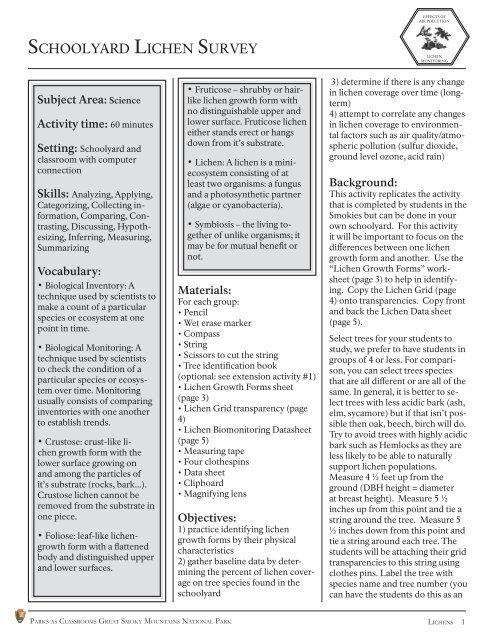
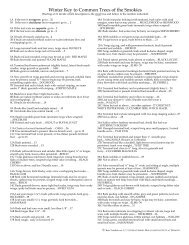

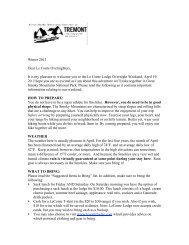
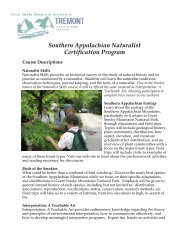

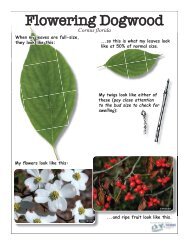
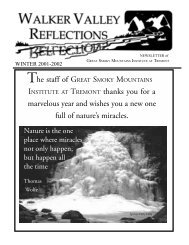
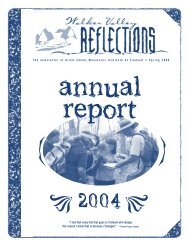
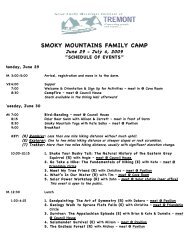
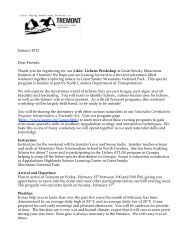
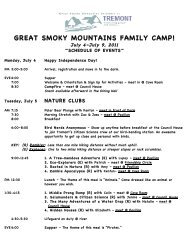
![Application [PDF] - Great Smoky Mountains Institute at Tremont](https://img.yumpu.com/22110613/1/190x245/application-pdf-great-smoky-mountains-institute-at-tremont.jpg?quality=85)
